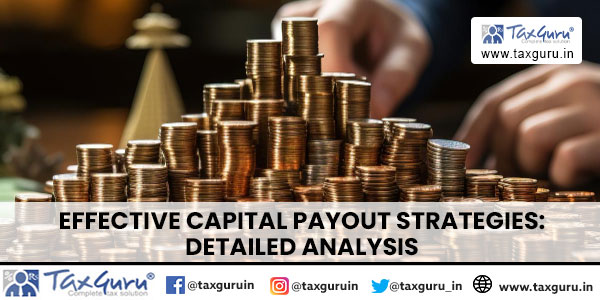
1. Introduction
In my previous article under the title ‘Understanding General Anti-Avoidance Rule (‘GAAR’) – Part 1’ , I had thrown light on the legal aspects of GAAR’s applicability and its consequences. GAAR gives the tax department unfettered power to challenge aggressive tax avoidance arrangements by tax payers. Recognising this situation, Dr. Shome Committee prescribed various safeguards while invocation of GAAR provision. The Parliament in its wisdom duly incorporated these safeguards under the Income Tax Act, 1961 (‘Act’).
In this article, I wish to discuss the procedural aspects with respect to implementation of GAAR.
2. Point of Initiation – Reference by Assessing Officer
The process to kickstart the declaration of an arrangement to be an impermissible avoidance arrangement shall by initiated by Assessing Officer (‘AO’) as per section 144BA (1) of Act. The AO during the course of assessment or reassessment proceedings, having regard to the material and evidence available before him, where considers that it is necessary to declare an arrangement as an impermissible avoidance arrangement, then, he may make a reference to the Principal Commissioner or Commissioner of Income Tax (‘CIT’) in Form No. 3CEG.
As per Rule 10UB (1) of the Income Tax Rules, 1962 (‘Rules’), the AO before making a reference to the Commissioner, grant the assessee an opportunity of being heard through issue of a notice in writing for seeking his objections, if any, to the applicability of provisions of Chapter X-A in his case. As per sub-rule (2) of the Rule 10UB, the notice shall contain the following –
i. details of the arrangement which is proposed to be declared as an impermissible avoidance arrangement
ii. the tax benefit arising under the arrangement
iii. the basis and reason for considering that the main purpose of the identified arrangement is to obtain tax benefit
iv. the basis and the reasons why the arrangement is an impermissible avoidance arrangement as per section 96 of the Act
v. the list of documents and evidence relied upon by the AO
3. Role of Commissioner of Income Tax
The task of examining whether the impugned arrangement is an impermissible avoidance arrangement shall pass onto CIT through aforementioned refence by the AO.
As per section 144BA (2) of the Act, the CIT shall, on receipt of a reference under sub-section (1) of section 144BA of the Act, if he is of the opinion that the provisions of Chapter X-A are required to be invoked, grant the assessee an opportunity of being heard through issue of a notice requiring the assessee to submit his objections within such period, not exceeding sixty days, as may be specified in the notice. The CIT shall provide in the notice the reasons and basis of his opinion for invoking provisions of Chapter X-A of the Act.
Case 1: Assessee does not furnish any objection to CIT’s notice
As per section 144BA (3) of the Act, where the assessee does not furnish any objection to the notice of CIT within the time specified, the CIT shall issue such directions as he deems fit in respect of declaration of the arrangement to be an impermissible avoidance arrangement.
However, no such direction would be issued by the CIT after the expiry of one month from the end of the month in which the date of compliance of the notice issued under sub-section (2) of section 144BA of the Act falls. [ Rule 10UC(i)]
Case 2: Assessee objects to CIT’s proposed action, however CIT is not satisfied by assessee’s objection
As per section 144BA (4) of the Act, where the assessee objects to the proposed action, and the CIT after hearing the assessee in the matter is not satisfied by the explanation of the assessee, then, he shall make a reference in the matter to the Approving Panel for the purpose of declaration of the arrangement as an impermissible avoidance arrangement.
However, no such reference shall be made by the CIT to the Approving Panel after the expiry of two months from the end of the month in which the final submission of the assessee in response to the notice issued under sub-section (2) of section 144BA of the Act is received by him. [ Rule 10UC(ii) ]
Case 3: Assessee objects to CIT’s proposed action and CIT is satisfied by assessee’s objection
Where the CIT is satisfied, after having heard the assessee’s objection that the provisions of Chapter X-A are not to be invoked, he shall by an order in writing, communicate the same to the Assessing Officer with a copy to the assessee.
As per rule 10UB(4) and 10UC(iii), where the CIT is satisfied that the provisions of Chapter X-A are not required to be invoked, he shall issue directions to the Assessing Officer in Form No. 3CEH within a period of two months from the end of month in which the final submission of the assessee in response to the notice issued under sub-section (2) of section 144BA of the Act is received by him.
Whereas, where the CIT is not satisfied by assessee’s objection and is of the opinion that provisions of Chapter X-A are required to be invoked, he shall before making a reference to the Approving Panel under sub-section (4) of section 144BA, record his satisfaction regarding the applicability of the provisions of Chapter X-A in Form No. 3CEI and enclose the same with the reference.
4. Reference to Approving Panel
The role of Approving Panel shall begin upon a reference being received by it from the CIT for declaration of an impugned arrangement as an impermissible avoidance.
4.1. Constitution of Approving Panel
The Approving Panel shall be constituted by the Central Government and shall consist of three members including a Chairperson.
The Chairperson of the Approving Panel shall be a person who is or has been a judge of a High Court.
One of the member of the Panel shall be a member of Indian Revenue Service not below the rank of Principal Chief Commissioner or Chief Commissioner of Income-tax. And the other member shall be an academic or scholar having special knowledge of matters, such as direct taxes, business accounts and international trade practices.
4.2. Powers of Approving Panel
On receipt of a reference from CIT, the Approving Panel may, before issuing any direction, require the following –
i. direct the CIT to carry out further inquiry
ii. call for and examine such records as it deems fit; or
iii. require the assessee to furnish such documents and evidence as it may direct.
The Approving Panel shall have all the powers which are vested in the Authority for Advance Rulings under section 245U of the Act.
4.3. Directions of Approving Panel
Section 144BA (6) of the Act empowers the Approving Panel to issue such directions, as it deems fit, in respect of the declaration of the arrangement as an impermissible avoidance arrangement.
However, no direction under sub-section (6) shall be issued unless an opportunity of being heard is given to the assessee and the Assessing Officer on such directions which are prejudicial to the interest of the assessee or the interests of the revenue, as the case may be.
If the members of the Approving Panel differ in opinion on any point, such point shall be decided according to the opinion of the majority of the members.
As per section 144BA (13) of the Act, directions by the Approving Panel must be issued within six months from the end of the month in which the reference was received from CIT.
4.4. Appeal against the directions
Section 144BA (14) of the Act provides that the directions issued by the Approving Panel shall be binding both on the assessee and the revenue. In order words, both the assessee and revenue would not have any scope to appeal against the directions of the Approving Panel under the provisions of the Act.
The said sub-section (14) of section 144BA of the Act shall have operation notwithstanding anything contained in any other provision of the Act.
Devoid of any remedy, the aggrieved party may have to resort to their Constitutional remedy by exercising Writ jurisdiction of High Court under Article 226 of the Constitution of India.
It may be pertinent to mention that an order in which any tax consequence have been determined under Chapter X-A would be appealable directly before Income Tax Appellate Tribunal (‘ITAT’) in accordance with section 253(1)(e) of the Act.
On harmonious reading of section 253 with section 144BA, it can be concluded that the ITAT shall not have any jurisdiction to examine directions of the Approving Panel under section 144BA (6) of the Act. In other words, ITAT would be in a position to examine only additions made by invoking GAAR provisions consequent to directions by CIT in circumstances prescribed under section 144BA (3) of the Act (refer point 3 case 1 above).
5. Assessment order by Assessing Officer
As already discussed above, powers to declare an arrangement as an impermissible avoidance arrangement is vested both with CIT [ in circumstances prescribed under section 144BA (3) of the Act] and the Approving Panel [as per section 144BA (6) of the Act].
Thus, the Assessing Officer, on receipt of directions of CIT or the Approving Panel under respective cases, shall proceed to complete the assessment or reassessment proceedings in accordance with such directions and the provisions of Chapter X-A.
As per section 144BA (11) of the Act, where any direction issued by Approving Panel specifies that the arrangement which is impermissible avoidance arrangement is applicable for any previous year other than the previous year under assessment or reassessment, the Assessing Officer shall complete the assessment or reassessment proceedings of such other previous year in accordance with Approving Panel’s directions. It may be noted that it shall not be necessary for the AO to seek fresh direction on the issue for the such other previous year.
Sub-section (12) of section 144BA of the Act provides another safeguard as per which, if any tax consequences have been determined by invocation of GAAR provisions, such assessment or reassessment order shall be passed with prior approval of CIT.
6. Conclusion
The Indian Income Tax Department is considered one amongst the most unsparing tax department when it comes to challenging aggressive tax planning strategies used by the tax payers. Armed with legislative tools to declare these arrangements as impermissible, it would be interesting to see how tax officers on ground implement it. Even though enough safeguards have been prescribed under the provisions of GAAR, the historical experience of harassment faced from tax department may give some tax payers sleepless nights. However, small tax payers may not have anything to worry in light of the prescribed threshold of rupees three crore of tax benefit in an assessment year.
(The author is a practicing Chartered Accountant based in Delhi and can be reached at paras@parasdawar.com or +91 9711107317)
Declaimer: The contents of this document are solely for informational purpose. It does not constitute professional advice or a formal recommendation. While due care has been taken in preparing this document, the existence of mistakes and omissions herein is not ruled out. The author does not accept any liabilities for any loss or damage of any kind arising out of any inaccurate or incomplete information in this document nor for any actions taken in reliance thereon. No part of this document should be distributed or copied without express written permission of the author.























